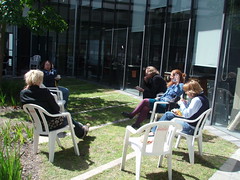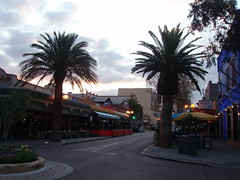September 23, 2007
DAC 2007
My recollection of the Digital Arts and Culture Conference (DAC) 2007 is unfortunately a bit blurred by some type of flu contracted in either Perth, Kuala Lumpur, or Tokyo, where I am now at my desk, writing amidst sniffling. But due to Scott’s invocation, I must post! Because I’m in Tokyo for the next conference up, DiGRA, and that’s sure to generate more reasons to post soon enough.

As a typical and enjoyable DAC, a cross-section of practitioners and scholars were in attendance,
with a marked lack of North Americans (at least Scott and I, with Harrell, Pearce, and Fullerton, were representing!). Some notable DAC originals were also missing (Juul, Aarseth, Frasca, Miles, and Markku), but the familiar faces and emerging scholars made the events and talks worth the unbelievably long plane ride. As typical a DAC, and as taken to heart by organizer Andrew Hutchinson, faculty at Curtin University of Technology, there was much time for discussion and debate in between sessions, and during lunches, and post-lecture. Lisbeth Klastrup was determined to get good documentation of this:

The art events of the Biennial all around Perth complemented the discussions in digital culture tremendously, even if they were highly focused in one thematic area (bio-art).
The speaker who kicked things off in the most exciting direction for me day 1 was Fox Harrell, who on the first day discussed his Griot Narrative system in terms of African diasporic orature. His talk was very much in line with the thinking of Michael Mateas, Simon Penny, Phoebe Sengers and Phil Agre, who espouse Critical Technical Practice, and the likeminded and similarly goaled work of my “activist design” work and the values at play direction. Patterning computational processes after cultural norms (but careful not to “represent” those aspects, merely use them as a model), Harrell’s work has been the most compelling to date I’ve seen that addresses the cultural study of code in a promising way. After, Torrill Mortensen presented a taxonomy of games research that will be highly worth reading and using in the classroom in her paper, “The real truth about what games researchers do all day” – methods, strategies and ethics of online multi-user games research.” Similarly useful and inspirational as both a theoretically interesting area and as a useful tool for digital media researchers, the paper “Interesting Times – Modelling Time in Multi-Player and Massively Multi-player Role Playing Games,” by Anders Tychsen & Michael Hitchens, where they espoused an iteratively developed model of “game time.”
In his paper, “Elements of Dadaist Practice in Contemporary Electronic Literature,” Scott Rettberg looked at Dada artists’ projects and their relationship to electronic literature. Starting from Raoul Housman’s “Tete Mechanique” of 1919 and other Dada artworks, Rettberg examined the way electronic writers have tended to use Dada-style techniques in their work, and teased out the rationale behind the use of such techniques. Commonalities, such as the rejection of the dominant modes of distribution, the elevation of the importance of audience response, abstraction, embrace of randomness, the diverse use of found objects, and the representation of the human body as a man-machine hybrid, were key to his argument that “decentered movements” such as the ‘movement’ of electronic literature are as distributed, unbound, contradictory, and rejecting of conformity as the Dada artists were.
From the Dadaist perspective, Rettberg argued, interesting art was just as likely to take place on the street, where no one form of art can claim predominance over another. Similarly, literary experiences made for electronic media are still distributed virally, and function by and large outside traditional publishing institutions. The way that electronic lit writers reuse and respond to existing works available to the general public could also correspond to the political interest of Dada use of language – that the language “handed down” has been corrupted and thus, must be re-invented – the political intention behind experimentation with language cannot be ignored.
Rettberg presented e-lit works from Maria Mencia and Jason Nelson to several works by Talan Memmott, who recently joined the faculty at BTH University in Sweden.
After Rettberg, Simon Penny gave his paper, “Experience of Abstraction,” in which he proposed not a methodology or a research project, but an attempt to dig down to the epistemological and philosophical issues when the culture of technological tools come into contact with the arts. The act of practice, Penny argued, brings to light the history of industrialized labor and militaristic applications: the machine itself has a cultural history. Penny admitted to an “abiding disquiet” regarding the disjunction underlying practice of technology (CS and Engineering as examples) and the practice of media arts, but no images or concrete examples were given to elucidate on this further. A deeply informed and more radical theory of practice, he noted, is missing from the culture of media arts, because media artists are by and large using technological tools which have inherent limitations, and are accepting those limitations. “You push against the materials, and the materials push back,” said Michael Mateas. But Penny takes this assertion one step further, “it’s the ideology that pushes back.”

Penny here is calling for artists to elaborate the distinctions which past cultural studies has failed to manifest. The largest conceptual issue, for Penny, centers around “problem solving,” and he argues that the kinds of intelligence lauded in the present “intellectual” age contrasts with concrete knowledge and hands-on craftwork. “We should be exceeding the instrumental definitions of technological practices,” noted Penny; Throughout his talk, Penny insisted on making the link (as he has since his 1996 book, Critical Issues in Electronic Media, and before) between the military and ideology inherent technological tools, noting that digital tools embody militaristic, cold war ideologies in their architecture.
On Day two, “In-Gayme Representation” by Adrienne Shaw, featured a textual analysis of discussion board posts from an online gay gamer community, and through excerpts and interviews, provided an insightful take on attitudes towards LGBTQ video game representation, and how the “gaymer” identity was constructed through the online. Ludica’s paper “A Game of One’s Own: Towards a New Gendered Poetics of Digital Space” discussed the gender implications of game spaces, calling for ” a new gendered poetics of game space, proposing an inclusionary approach that integrates feminine conceptions of space into the gaming landscape.”
The paper, “Platform Studies: Computing and Creativity on the VCS, MPC, and Wii” by Nick Montfort and Ian Bogost, was not presented by either author, but by stand-in-reader Harrell, who performed excellently under the pressure of reading a very detailed text. The paper met with a great deal of conversation among the audience members about platform and code and culture. A few questions centered around the context of each platform. A question arose as to whether the hardware investigation could stand aside from cultural context.
Some of the practice work presented during the conference was especially engaging. Ana Sánchez-Laws’ “Angie against the world” game explored the invasion of Panama by U.S. forces in 1989. Jim Bizzocchi explored “The Aesthetics of the Ambient Video Experience” and showed ambient natural videos. The artists in the BEAP (some on hand, such as Orlan, to discuss her work) had “edgy” projects which appeared to be classifiable on a spectrum from “critical technologies” which caused the visitor to consider the boundaries of life and technological intervention, to “playing god” in which there was little evidence of criticality.
All of the DAC abstracts can be found here, and soon, all of the papers in their final format will be online. I hope everyone gets a chance to take a look!!
ps thanks to Lisbeth Klastrup’s immediate penchant for flickering, the images included herein are hers!

September 23rd, 2007 at 10:14 pm
I’m at DIGRA as well, so Grand Text Auto has two correspondents on the ground. I was at the Tokyo Game Show yesterday. Will blog about DIGRA and Tokyo Game Show soon.